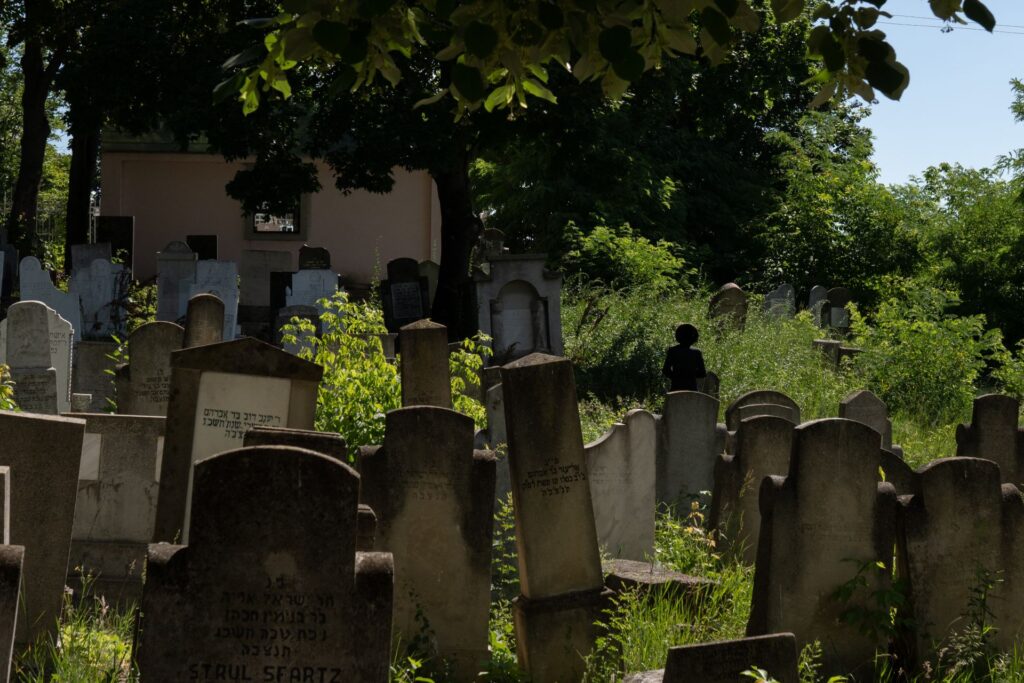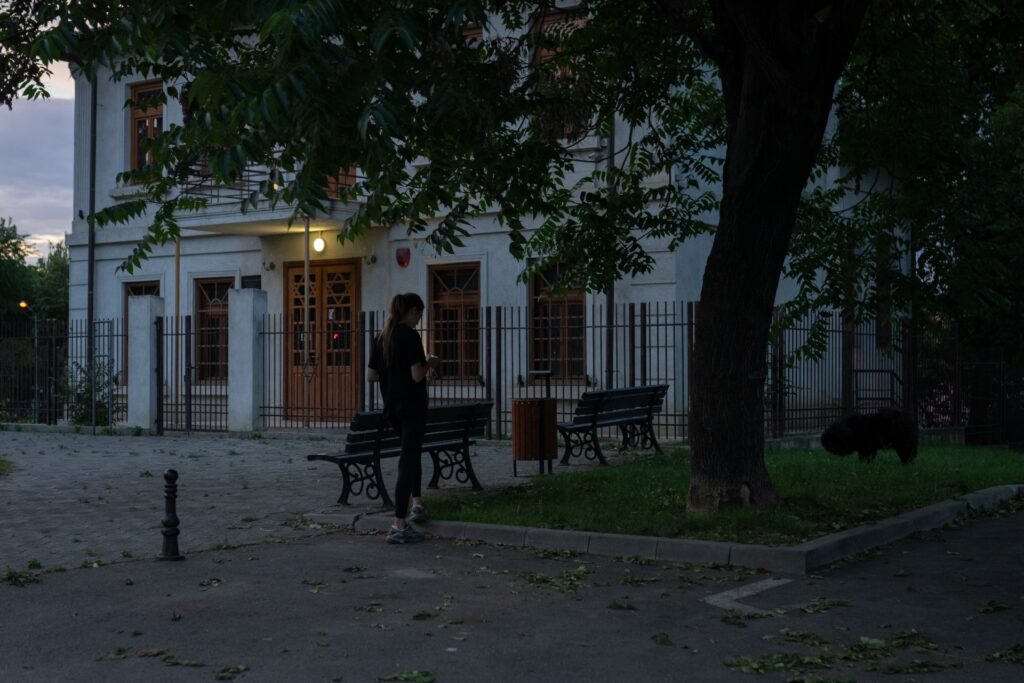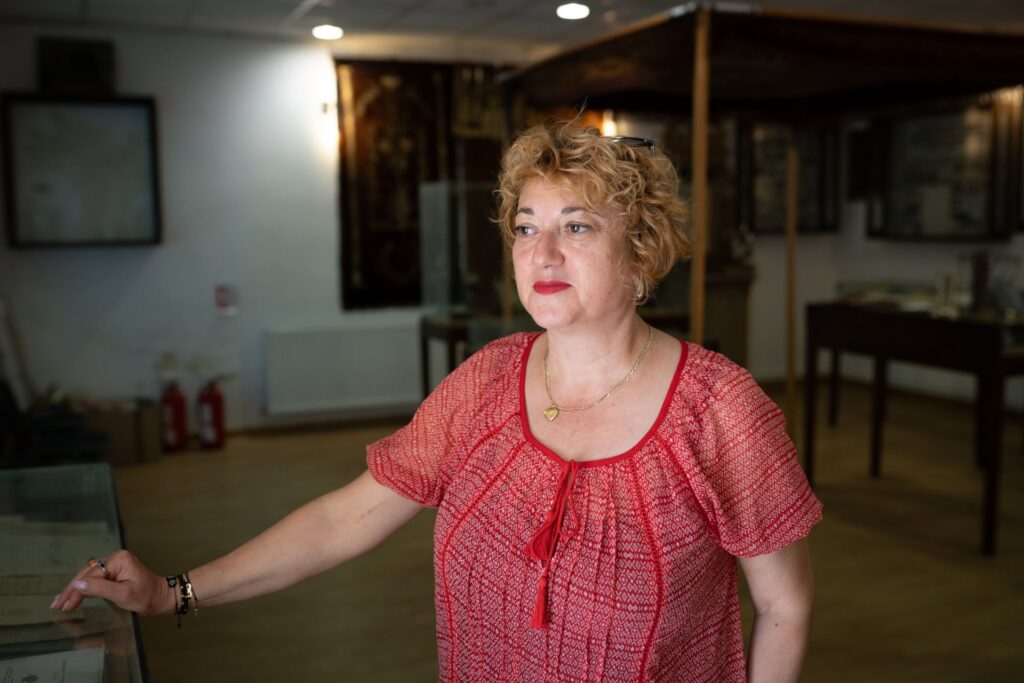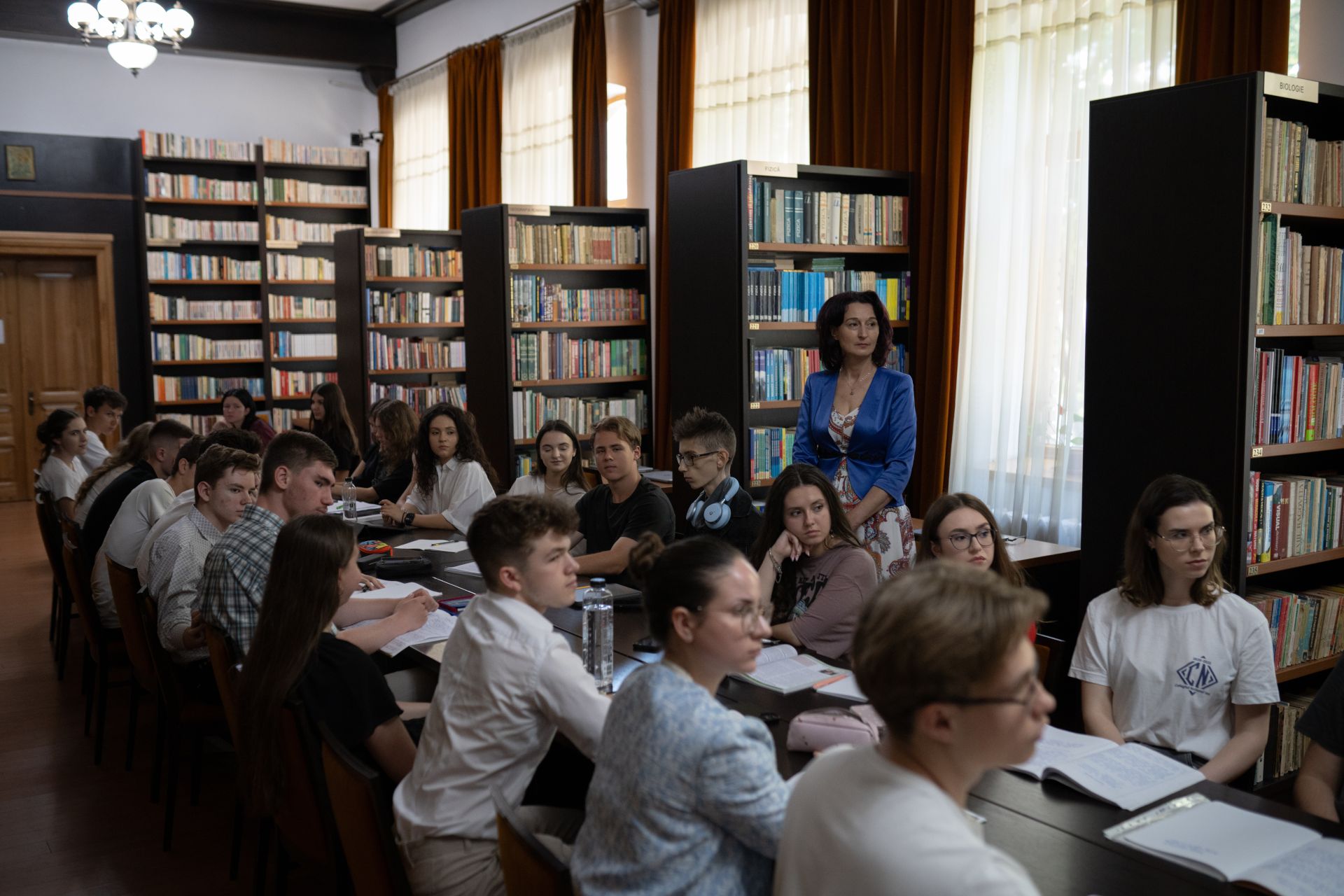Every Thursday morning students at Iasi National College in northeastern Romania sit down to make history. Supervised by their teacher, Adriana Radu, a tall, prim woman with dark plum hair, the class is one of the first to take Romania’s new mandatory high school course on the Holocaust and Romanian Jewish history.
Meeting in the school’s elegant library that boasts vaulted ceilings and towering bookshelves, the 24 young scholars have been on an eye-opening, and at times emotional, journey since the course was rolled out in September 2023.
Most of the students knew nothing of their country’s role in the mass murder and deportation of hundreds of thousands of Jews during World War II or the dehumanizing rhetoric that foreshadowed the atrocities. Romania joined the Axis powers in November 1940 and helped to invade the Soviet Union the following summer.
“I was shocked about Romania’s role in the Holocaust,” Alma Flegher, an 18-year-old student, told New Lines during a recent visit to her school. “Everybody has been impacted by it in different ways, but all our class have found new information that brings a better understanding of our country’s past.”
In areas Romania controlled, the country killed upward of 380,000 Jews, as well as 11,000 members of the Roma community. Information in the Romanian public sphere has been scarce; the country did not admit it took part in the killings until 2003. Prime Minister Marcel Ciolacu, referring to the new course, has said this is part of the country “facing the dark side.”
The new course, called The Holocaust and Jewish History, was passed into law in November 2021 after Romanian lawmaker Silviu Vexler, who is Jewish, introduced it. All parties supported it except the far-right Alliance for the Union of Romanians (AUR), which argued that the Holocaust in Romania was a “minor topic” and that focusing on it would undermine the quality of students’ education. The party also claimed that there were no longer any serious cases of antisemitism in Romania, a statement rebuffed by the Elie Wiesel National Institute for Studying the Holocaust in Romania, which has issued annual reports concerning the anti-Jewish rhetoric that continues to surface around the country. In recent years, vandals have upturned Jewish gravestones and defaced the childhood home of Romanian-born Wiesel, a Nobel laureate and survivor of the Auschwitz concentration camp.
The course was made mandatory for all 11th graders across the country, the penultimate year before high school graduation, and joined a list of other classes on the curriculum such as Romanian literature, physical education and foreign languages. Its implementation is a distinct departure from other countries in the region. Both Poland and Hungary have grappled with Holocaust reconciliation. While Poland has preserved sites like Auschwitz and integrated Holocaust studies into school curricula, the recently ousted Law and Justice party, which left office in December after eight years, promoted narratives that downplayed Polish involvement in the mass murder of Jews. Similarly, in Hungary, the illiberal Prime Minister Viktor Orban has depicted his country as a victim of Nazi Germany while ignoring the regime of Miklos Horthy and his collaboration with Adolf Hitler.
For the students in Iasi, learning Jewish history has also equipped them with skills to counter extreme narratives as Romania struggles with the far-right winds that are sweeping across Europe. In June, Romanians elected six members of the AUR to the European Parliament, a significant increase from the one seat the party previously held.
They learn about the history of Jews, from antiquity to World War II, using testimonies and personal stories to plough through the difficult material. Some of the students in Iasi see parallels with today.
“There are a lot of extreme people in this country who promote their ideas on social media, and they have young followers,” said Carina Ezaru, an 18-year-old student who will take part in the first Romanian-Jewish history olympiad, an annual academic competition for Romanian high school students.
Founded in 2019 and led by the social-media-savvy George Simion, the AUR has espoused nationalistic and antisemitic views. It has also heavily criticized the European Union, NATO and Romania’s support for neighboring Ukraine in defending itself against Russia’s invasion of the country. In 2020 the party shocked the nation by winning 9% of the vote, becoming a key opposition to the ruling coalition led by the pro-Europe Social Democratic Party. Like other far-right parties across the continent, it is Euroskeptic and plans to overhaul EU measures tackling climate change. The AUR describes its four pillars as faith, liberty, family and nation. Its Christian-nationalist ideology opposes same-sex marriage and supports traditional family values. Its upward swing looks set to continue as Romania heads toward parliamentary elections in December: The party is currently placing third in the polls.
The teacher Radu is equally concerned. Having designed the national curriculum with Romanian-Jewish history scholars and researchers at the behest of the Ministry of Education, the educator sees the course as key to shaping future Romanian citizens, ones able to think critically about the past and ask questions that push them toward the truth. For the past 20 years, Radu — who is not Jewish — has taught Jewish history at the high school level, in a predecessor course of the new mandatory one, which is distinct from a general history class. And although the number of her students has grown because of mandatory participation, she still sees the same reaction in class: How was this massacre possible? In Iasi, students also have to comprehend the fact that the first act of the Romanian Holocaust, the Iasi Pogrom, started in their city, just a few minutes down the road in the old police station.

Romania’s role in the Holocaust was mostly ignored under the communist regime of Gheorghe Gheorghiu-Dej, which began in 1947. Under the 1965-89 leadership of Nicolae Ceausescu, another communist, Romanians were told that the wartime dictator Marshal Ion Antonescu saved the country’s Jewish population by stopping death camp deportations toward the end of World War II. This was selective picking of history.
In August 1939, Germany and the Soviet Union signed the Molotov-Ribbentrop Pact, an agreement that worsened the geopolitical standing of the Kingdom of Romania, which had to cede the territories of Bessarabia and North Bukovina to the Soviets. At the time Romania was a neutral state. But driven by fear of a Soviet invasion, it joined the war in 1940 in support of Nazi Germany. Infuriated by the loss of Romanian land only six months earlier, Antonescu accused Jews in these territories of colluding with the Soviets before the Molotov-Ribbentrop Pact was signed. The allegation was cover for deep antisemitism that ran across Antonescu’s government and Romanian society at large.
For the first five months of Antonescu’s rule, starting in September 1940, he joined forces with the fascist Iron Guard movement, ratcheting up antisemitic legislation and supporting attacks on Jewish communities in order to “Romanianize” the economy. In early 1941 Antonescu fell out with the Iron Guard and its leader, Horia Sima, after they launched a coup against him in order to seize total power. But despite members of the Iron Guard being rounded up and imprisoned, antisemitism remained. Months later, as 585,000 Romanian troops were getting ready to invade the Soviet Union with their German allies, Antonescu claimed that the Jewish community near the border was spying on behalf of the Russians and forewarning them of military maneuvers.
This set the stage for the Iasi Pogrom, starting on June 28, 1941, which resulted in the mass murder of over 4,000 Jews in the city’s police station. Alongside the killings, several thousand more Jews from the area were locked into cattle wagons and deported to northern and southern Romania. The population of the community in the city, where Sephardic Jews first settled in the 15th century, was halved.
To help the Romanian soldiers carry out the operation, members of the Iron Guard were released from prison. Overall, at least 13,000 people were killed in one of the bloodiest massacres committed by Romanians during the war. When Romania later reclaimed Bessarabia and North Bukovina, the attacks on Jews in those areas worsened. Twenty thousand Jews were murdered in Odesa when the Ukrainian city was under Romanian control. Thousands more were killed in camps and ghettos across the Transnistria governorate at the behest of Antonescu.

“Jews were the biggest minority in Romania before the war,” said Nicoleta Dabija, a coordinator at the Iasi Pogrom Museum. Before World War II there were approximately 750,000 Jews in the country. “But it was also the case that while pogroms were happening, the Jewish theater in the capital Bucharest was still functioning,”
It is small paradoxes like this that has allowed denialism about Romania’s role in the Holocaust to thrive, often ignoring Romania’s de-facto, two-tier treatment of Jews, which explains why the Jewish theater was allowed to remain open while massacres of Jews in border areas were carried out.
When the Romanian revolution began in 1989 and the communist regime of Ceausescu ended, Romania began to further confront its role in World War II. But unlike regional neighbors like Poland, Romanians retained the belief that their country was among the safest places for Jews during the war.
This was due to two historical factors. The first was that after World War II, Bessarabia and North Bukovina were annexed into the Ukrainian Soviet Socialist Republic and the Moldovan Soviet Socialist Republic, becoming part of the Soviet Union. With the change of borders came the exportation of memory. The crimes that happened in those territories became Ukrainian and Moldovan crimes too. The second was the fact that Antonescu did not persecute Jews as much in Romania proper, lands that were within Romania’s pre-World War II borders, which included Bucharest. Although they were not rounded up and murdered en masse, Jews in these areas were subject to discriminatory laws and forced labor. In fact, plans were in place for Antonescu to export most of Romania’s Jews to camps in Poland, but a last-minute decision halted the scheme — Antonescu’s realization that Nazi Germany and its allies were on the losing side of the war. It was not a guilty conscience about sending thousands of people to their deaths that stopped plans.
The Holocaust and Jewish History high school course has been a turning point for Romania on the issue of reconciliation. “We went from nothing to this. It’s a big jump,” said Radu, the teacher.
But the transition hasn’t been completely smooth. The textbook for the course wasn’t finalized until February, meaning teachers had to work from the course template with makeshift resources. A lack of training for teachers before the academic year began has also been controversial, the result of bureaucratic oversight and the Ministry of Education’s focus on rolling out the curriculum for students first. While teachers like Radu have taken an active interest in Romanian-Jewish history, she acknowledges that a preparatory course for other educators would have been beneficial for the rollout. Dabija, from the Iasi Pogrom Museum, takes a firmer stance. She believes Jewish history education for teachers would not only have leveled up the quality of education across the country, but also would have helped to identify and potentially quell antisemitism in some classrooms. “Some people genuinely feel they don’t know enough to teach, but others can be antisemitic and not see the value in the course,” she told New Lines.
In search of information, the number of teachers visiting the Iasi Pogrom Museum has grown in the past 12 months. Met at the door by Andreea Ursache, a 39-year-old museum custodian, visitors are taken through the events of June 1941 step by step, from information on the registration of Jews on the day of the massacre to harrowing photos of bodies being removed from cattle wagons days after the shooting began. Dozens of students have also come eager to learn; some have even fainted from fright after being confronted with the museum’s offering.
This rush of enthusiasm is in stark contrast to the reception the museum received when it first opened its doors in June 2021. At the time, several members of the community questioned the museum’s relevance when speaking to museum staff or commenting on social media. “We had a few visitors after we opened who couldn’t comprehend what happened in Romania during the war; it was a real psychological defense,” Ursache said in a careful and gentle tone. A reluctance to dive into the past has also been evident among students’ parents. Ezaru, the 18-year-old student, said her parents initially questioned the need for the new Jewish history course. “They were surprised and perhaps thought there were more important things to study,” she said. But the past nine months have also been an education for this older generation, most of whom never learned about this chapter of history in school.
“Now they are actually intrigued by what I’m learning,” Ezaru added.
Jewish history is hidden in plain sight in Iasi. Before World War II, over 43,500 Jews lived in the city, and there were approximately 146 synagogues. Today, only 326 Jews and two synagogues remain. This is not only the result of the Holocaust but also due to the “sale” of Jews to Israel during the communist period. Hiding antisemitism under the guise of diversifying the Romanian economy away from dependence on Moscow, Ceausescu allowed 2,000 Jews a year to immigrate to Israel in return for a fee paid by the Israeli government. The average price for a person depended on age, education and profession, scholars say, and varied from $2,500 to $3,500 per individual. The would-be emigrants received nothing; all the money was given to the Romanian government. In total, around 40,000 Jews left the country during Ceausescu’s rule. Today, only 8,900 Jews live in Romania, according to the World Jewish Congress — just over 1 percent of the prewar population.
Standing inside the door of her makeshift Jewish history museum, Benjamina-Ides Vladcovschi, the president of the Jewish Community of Iasi, lamented the slow erosion of her community during and after Ceausescu’s rule.

As a young girl growing up in the city, she remembered a small but vibrant support network around her. There were crowds in the synagogues rebuilt after the war and vibrant community events. But like her non-Jewish neighbors, she knew nothing of the Iasi Pogrom and the true horrors of the Holocaust.
“I was 20 when I learned about the massacre; that’s how hard it was for people to talk about it,” Vladcovschi told New Lines. Hanging on the walls of the museum, which was moved from Iasi’s main synagogue for safer keeping, were photos of famous figures from the Jewish community, most long dead or settled in Israel. “It’s only older people here now, and we do our best to support them with their care needs,” Vladcovschi said. Both of the city’s synagogues are locked to visitors, and for religious ceremonies, a Romanian-speaking rabbi from Israel is flown in.
Vladcovschi and her colleagues at the community center have welcomed the new high school course and see it as a meaningful step to combat antisemitism. Although physical attacks on Jews or Jewish spaces are rare in Romania, hate can still be found online.
“This course gives people the tools to combat hate and take action,” Vladcovschi said.
But she is aware that healing the wounds of history will take many more generations as awareness trickles down slowly. While mandatory education has been a powerful start, there is still more work to do in reclaiming Jewish spaces across the country. That work will take years and be an upward battle, owing to bureaucracy and hesitancy among local politicians who question the ownership. But Vladcovschi and her community are up to the task.
“Romania is my home,” she said. “I’ll never leave.”
Become a member today to receive access to all our paywalled essays and the best of New Lines delivered to your inbox through our newsletters.



